Biological Age
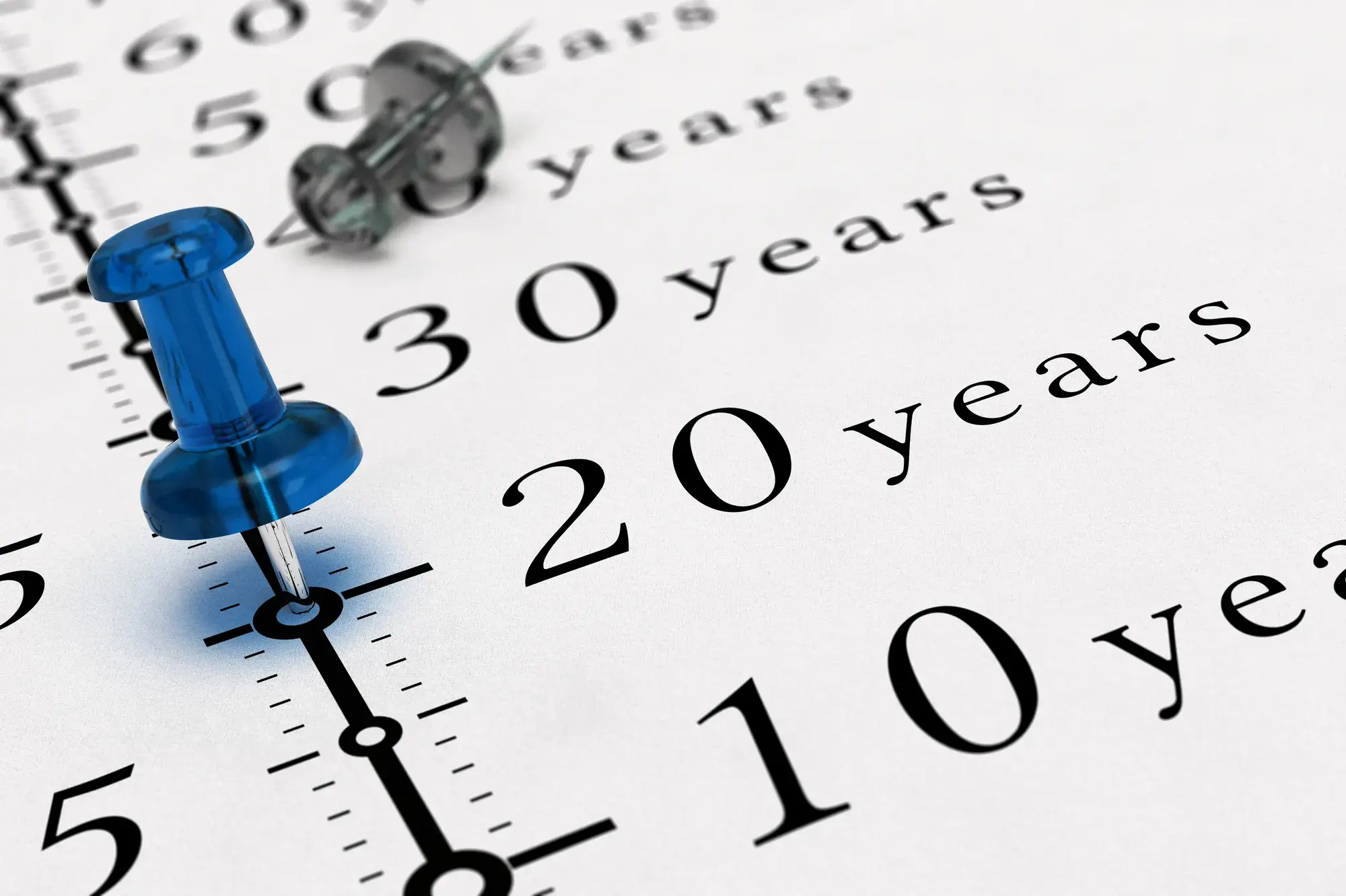
Using Biological Age Vs Chronological Age Calculator
Read More
April 4, 2024
If you experience fear of growing old, you are not alone. A 2014 survey shows that nearly 90% of Americans are afraid of the implications of aging, from an increased risk of disease to declining physical ability. However, this fear often stems from two assumptions: that getting old is synonymous with disease and that you have no power over the aging process. These aren’t necessarily the truth.
There’s a lot that needs to be understood about the complex process that is aging. However, since the introduction of concepts such as biological aging and aging biomarkers in 1988, science has made significant advances.
Today, we know that your true age is defined by more than the date on the calendar or the number of candles on your birthday cake. Instead, your biological age is a more accurate indicator of how old your body is, as well as of what disease risk profile you are facing at any point in life.
Unlike chronological age, biological age can be influenced and reduced with the right interventions. And, with RELATYV, you can also access a comprehensive tool to track your biological age and intervention progress in real-time. Let’s cover all you need to know below.
American developmental biologist Scott F. Gilbert defined aging as “the time-related deterioration of the physiological functions necessary for survival and fertility.” More broadly, the term aging can be used to describe the biological processes associated with the passing of time, which lead to physical and cognitive decline. These changes, which are often permanent, affect any aspect of our body and mind, from cells and organs to the body’s own systems.
Most theories link the beginning of the aging process with cellular senescence – or, in simpler terms, cellular retirement. This occurs when the cells in our body cease to divide, often in response to different triggers, including DNA damage and dysfunction of the telomeres (the protective caps at the ends of our chromosomes).
In certain scenarios, this process is critical because it prevents damaged or stressed cells from propagating, aiding in tumor suppression and wound healing.
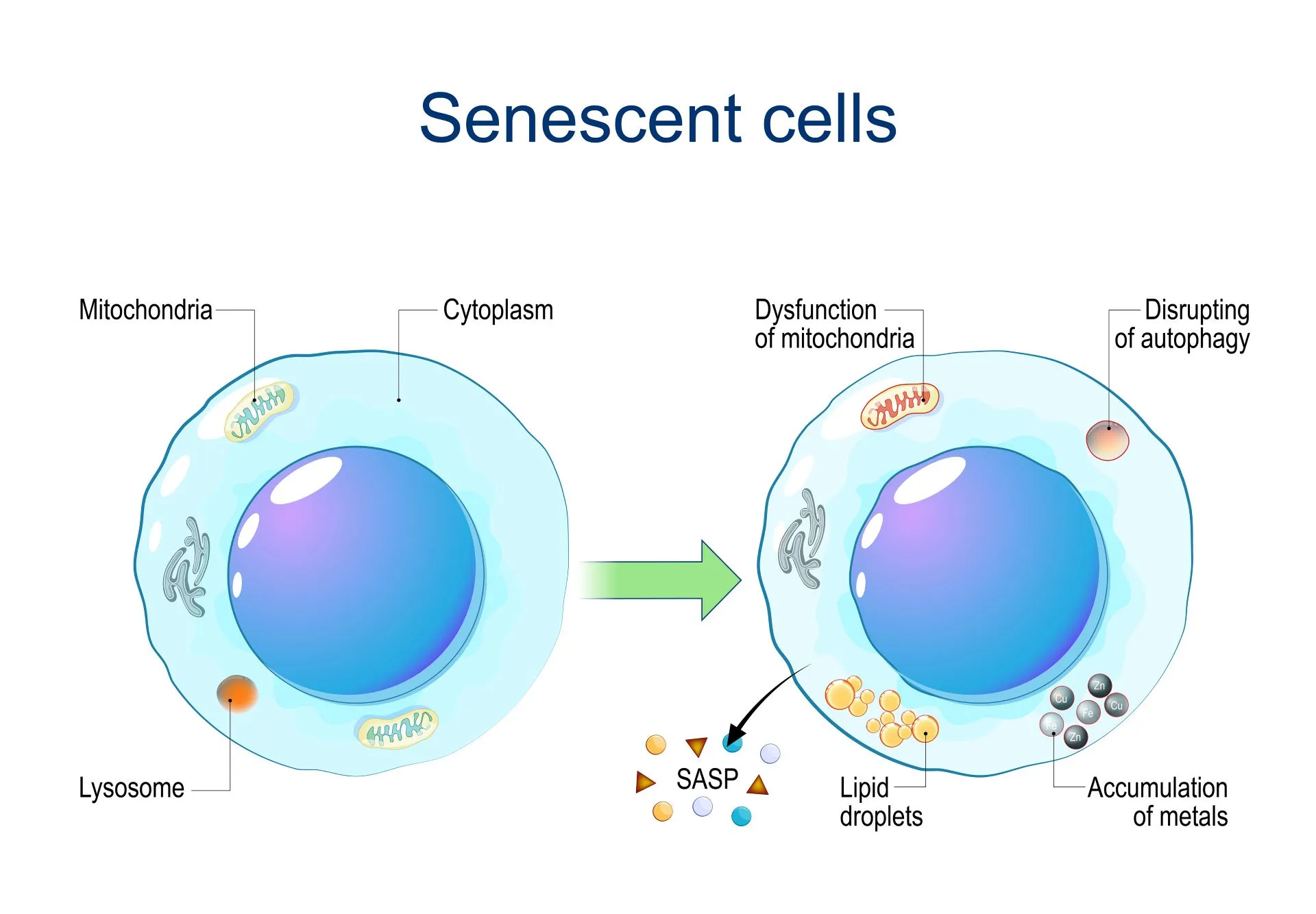
However, when cells stop dividing, they also stop acting as young, healthy cells – which can lead to a decline in the reserves of progenitor and stem cells, which are essential to replace damaged cells and tissues and to keep the body working properly.
Additionally, the accumulation of waste materials from older cells can begin to accumulate and kickstart diseases commonly associated with aging.
Several theories have attempted to explain why cells, at some point in our lives, stop dividing. Some, like the Hayflick Limit, suggest a sort of biological countdown. Others link the accumulation of cell byproducts (known as free radicals) or damage to the energy-producing center of the cell (mitochondria) to aging.
More recently, studies have begun to uncover the connection between aging and telomere shortening. Telomeres shorten at each cell division cycle. When they become too short, they can leave the chromosomes unprotected and cause genome instability, eventually leading to cellular retirement.
We’ll look at the relationship between telomere length and aging in more detail below.
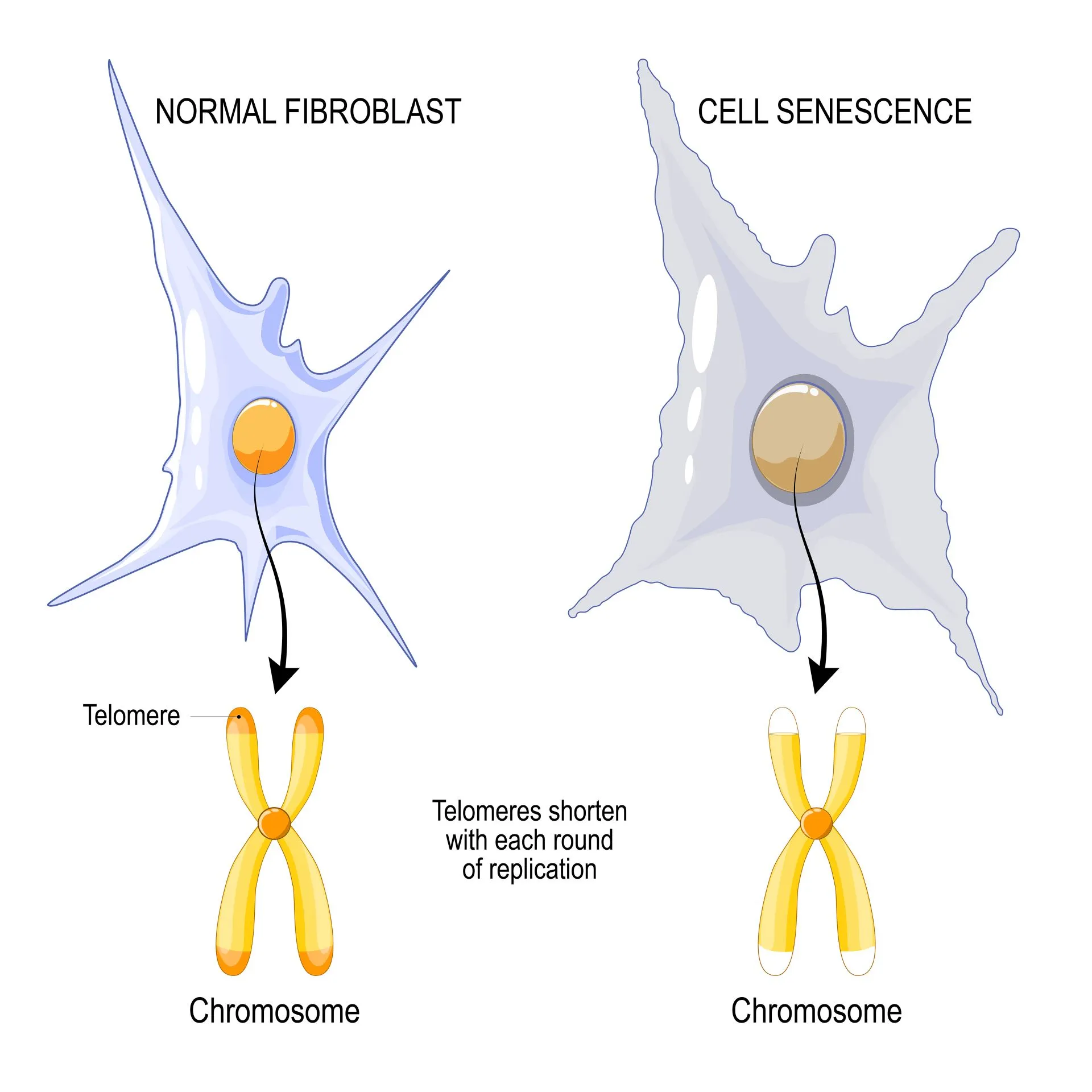
Chronological age and biological age are two different measures that can be used to determine how your body is aging. Unlike chronological age – which simply tells you how much time has passed since your birth – biological age is a more accurate indicator of how old your body is, how long you can expect to live, and what your disease risk profile is. Recent research findings link biological aging with cellular retirement.
Chronological age represents the exact amount of time a person or organism has existed, typically measured in units such as years, months, or days since birth. It’s a fixed, easily quantifiable measure, independent of health status, lifestyle choices, or genetic factors. In other words, you can always know how old you are based on your chronological age.
Nonetheless, while this is a useful marker of time, it doesn’t necessarily reflect biological age, which may be influenced by a multitude of factors including genetics, environmental exposure, and lifestyle habits. Unlike biological age, chronological age cannot be modified.
Biological age refers to how well your body functions compared to your chronological age. It is a dynamic measure of one’s health and vitality. It determines how well your body’s cells and systems are functioning and how fit you are compared to the standard for your chronological age range.
For instance, a person may be chronologically 50 years old but due to a healthy diet, regular exercise, and optimal stress management, their biological age may be measured as 40. This figure indicates that they have a health and risk disease profile akin to an average 40-year-old, showing that, biologically, they are aging at a slower rate.
Similarly, two people with the same number of birthdays can have different biological ages, depending on how they are aging internally, due to genes and lifestyle choices.
By telling you how old your body truly is compared to your chronological age, biological age also more accurately predicts your disease risk profile, lifespan, and expected healthspan (the number of years lived without chronic illness or disability).
Unlike chronological age, biological age can be modified by addressing the factors that influence this measure. These factors include:
Having a “give up” mentality can also make you age faster. If you feel you’ll never be able to overcome medical conditions or improve your health, you are more likely to give up trying, which can lead to poor lifestyle choices that make you age faster.
Over time, these factors can influence the rate of cellular retirement and telomere shortening, which accelerate the biological aging process.
Your chronological age simply states how many days, months, or years you’ve lived – it does not provide any information regarding how well your body’s system functions, how old you are internally, or how likely you are to develop dementia or diabetes. It is truly just a number.
On the other hand, you can think of biological age as depicting a comprehensive picture of your aging rate and body function, based on physiological evidence. According to studies, biological age can be used as a predictor of the onset of diseases associated with aging, including dementia, as well as other aging-related diseases.
Chronological age is very easy to calculate by looking at the passing of years and days – counting your biological age, on the other hand, can be more challenging and require specialized tests.
Medical diagnostics today look at a wide range of indicators that describe several aspects of how your body is aging and may predict your disease risk. These “indicators” are known as biomarkers of aging, a concept initially introduced by Sprott et al in 1988.
Over the past years, science has progressed in leaps and bounds and, today, doctors are able to use a wide range of more accurate predictors compared to the ones used in the 1980s. Thanks to advanced technologies, these indicators are also more accurately measured, offering precise estimations of a person’s biological age.
Two of the main biological markers used today to determine internal age-related changes are telomere length and DNA methylation.
In simple terms, telomeres are cap-like structures at the end of our chromosomes that protect them against deterioration. They are composed of repetitive sequences of non-coding DNA that protect these chromosomes – just like the plastic tips on shoelaces protect from fraying.
With each cell division, these telomeres get shorter. Once they become too short, the cell is unable to divide and becomes senescent (goes into cell retirement) or dies. Scientists have seen that telomeres get shorter as we age (i.e. as our chronological age increases).
However, the rate at which they shorten is also determined by a wide range of factors, including lifestyle, environment, exposure to pollutants, stress, and inflammation. Because of this, telomeres are often considered to be our “biological clock.”
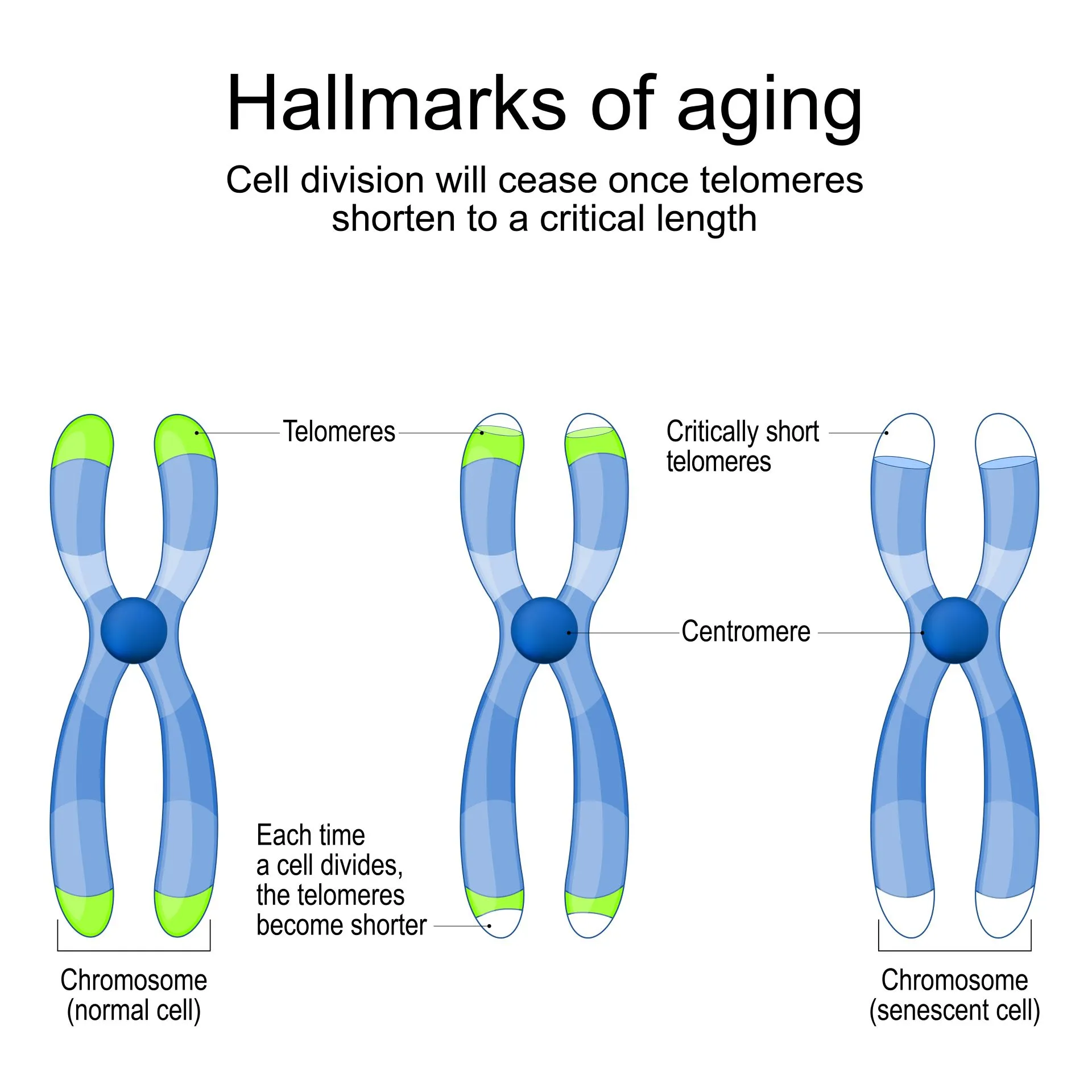
Over the past years, the global scientific community significantly focused on the implications of shortening telomeres. Some key research findings include:
The results of earlier studies are consistent in linking shorter telomeres with chronic illness, neurodegenerative disorders, shorter longevity, and earlier death.
To understand what DNA methylation is, it is important to consider DNA as something dynamic and able to change. In particular, not all genes in the DNA are “expressed” at any given time. Some of your genes may be switched “off,” while others are “on” (or are expressed) due to internal or external factors.
For example, a certain gene that regulates inflammation in your body may have been functioning, or on, since your early days. Encountering chronic stress or adverse lifestyle changes later on in life can prompt the gene to shut down or turn off.
As a consequence, you may start to experience increased inflammation, which can make you suddenly more prone to frequent illness or even chronic diseases such as heart disease or diabetes.
The process used by the DNA to turn genes on or off is known as methylation. This biological process involves the addition of a methyl group (CH3) to the DNA molecule. This modification doesn’t change the DNA sequence itself, but it may switch genes on or off, in a process known as gene regulation.
Methylation patterns can change over time, and they are often influenced by age, lifestyle, environment, and disease state. It is estimated that the human genome contains 28 million methylation sites in the DNA, several of which change with age – making the DNA methylation rate an accurate predictor of biological age.
As we age, variations in DNA methylation become more frequent: the rate at which genes are regulated can increase in some areas of the body (e.g.: soft breast tissue, which has been seen to be as much as three years older compared to the rest of the body) while others decrease.
Chronological age is commonly used as a risk factor to determine the level of risk for a range of diseases. For example, it’s widely accepted that adults aged 65 and older have a higher risk of diseases like cardiovascular disorders, diabetes, osteoarthritis, stroke, and cancer.
It is easy to see why chronological age is used in determining disease risk instead of biological age: this figure is easily accessible to both patients and healthcare providers. For instance, when a patient turns 65, their doctor will encourage them to stick to routine screening tests and take preventative measures.
However, there’s a caveat.
Let’s look at a patient who is chronologically 55, but has a biological age of 65. Their risk of disease is much higher than their chronological age would suggest.
As a result, they may not undergo screening tests or adopt lifestyle interventions that could modify their disease risk and protect them from complications. Left undetected, a higher biological age can make patients more prone to disease and disability as they age, which can kick-start a negative loop of chronic illness and add to the healthcare burden.
Over time, this can lead to a snowball effect: not implementing the right lifestyle interventions can increase the rate at which you are aging, which can exponentially increase your disease risk, ultimately affecting your longevity and lifespan.
It’s easier to think of biological age this way: your body doesn’t know how many birthdays you’ve celebrated, it only knows how well or badly your systems, organs, and tissues are aging internally. Consequently, it can act as the body of a younger or older person.
If you are biologically 10 years younger than your chronological age, your body is likely to match the health and disease risk profile of your biological age, not your chronological age. This can impact how long you’ll live and, more importantly, how many years you can live without disability or chronic illness.
Chronological age does not directly impact biological processes – rather, it gives us an indication of how old we are at any given point in life and what to expect from our health. For example, according to the Centers for Disease Control and Prevention, most breast cancer cases are diagnosed after the age of 50.
So, if you are approaching this milestone, you may wish to undergo screening tests for early detection.
Nonetheless, as we have seen above, your chronological age does not paint the full picture. For example, due to poor lifestyle choices and environmental factors, you may be aged 40, but have the same breast cancer risk level as a 50-year-old.
Chronological age intersects with biological age because, ultimately, as time passes, the state of our tissues, organs, and systems begins to decline. But the rate at which this happens is better outlined by biological age, which describes the rate of cellular retirement.
In turn, by halting cell division, cellular retirement determines how well the body’s tissue, organs, and systems function, and at what rate their function declines. Functional decline can affect the internal part of your body – such as organs and tissues – but it can also manifest with visible signs, such as reduced energy and mobility, skin changes, and memory problems.
Above, we’ve looked at the fact that chronological age is just a number, which doesn’t necessarily describe how well the body is doing internally. So, why do we let it define us?
There are several reasons for this:
Our mindset plays a vital role in helping us control the rate at which we age. When we have a positive mindset, we are able to find purpose in life and stick to healthy lifestyle choices. For example, if you feel more energized and determined to stay healthy, you will find it easier to exercise regularly, eat healthy meals, and socialize.
On the other hand, if you are plagued by chronic illnesses and declining mental health, you are more likely to experience depression, social isolation, a sedentary life, and diseases like diabetes, obesity, and cardiovascular disorders – which further aggravate the picture.
Our mindset can also be influenced by our assumptions. Some people get ill just after celebrating their 60th birthday, simply because they now believe they are “old.”
Similarly, if you are in your 60s or 70s, experience declining health, and see yourself as old, you are more likely to think “I’m getting old, my health can only get worse – so, why try?” Think of this as a self-fulfilling prophecy.
These are boundaries that we set in place and dare not cross. But they are just that: self-limitations. Research confirms that even simply thinking that you are young and can improve your health can have a profound impact on your life.
In a 1979 study by Ellen Langer – known as the “Counterclockwise” experiment – a group of older adults was asked to spend five days in a retreat and live as if they were 20 years younger.
The results? Better hearing, memory, grip strength, vision, joint flexibility, manual dexterity, IQ, gait, and posture. The participants also experienced lower arthritis pain levels and appeared significantly younger after the retreat.
Besides our own mindset, external factors such as societal views and stereotypes associated with aging can also cause us to define ourselves by our age. Ageism can negatively impact a person’s quality of life, self-esteem, and health outcomes.
In practice, when people are perceived as old, they begin to act as old. They may begin to rely more and more on caretakers and cultivate feelings of hopelessness. This can cause them to take actions such as going into retirement or interrupting hobbies, which, in turn, inhibits their productivity, contribution to society, life purpose, social life, and mental and physical health.
Not only does this place excessive strain on a person’s well-being, but it can also contribute to the burden placed on their families, healthcare system, and pension scheme.
Knowing what your biological age is compared to your chronological age can help you plan interventions and lifestyle modifications to ultimately improve your disease risk profile, increase longevity and healthspan, and boost overall wellness.
Knowing that you can modify your biological age is also important to rebuild your mindset and prevent your chronological age from defining you.
Understanding your biological age provides invaluable health insights – it can work as a barometer that indicates your susceptibility to diseases before symptoms appear.
Knowing your level of risk can help you seek early intervention and medical advice, reducing the severity or even preventing conditions commonly related to age, from dementia to diabetes. By tackling your risk of disease early on, you can extend your healthspan and longevity.
Consider your biological age as a starting point to seek effective anti-aging interventions that will, in time, help you control your biological age and rate of aging. The goals of these strategies are to:
Tracking your biological age offers objective measurements of health progress – more so than just tracking your chronological age. This data can help you better understand how different lifestyle modifications, medications, interventions, or therapies impact your health.
Therefore, it helps to make informed decisions and adjustments, leading to better, more sustainable health outcomes.
Above, you’ve learned that biological age can be modified. With the right interventions, you can not only slow down the rate of aging but also reverse it.
Although these interventions should be planned by a specialist around your unique goals and needs, some key anti-aging strategies include:
For example, NAD+ (nicotinamide adenine dinucleotide) plays a critical role in energy metabolism and the reduction of oxidative stress. Polyphenol like resveratrol can help reduce the risk of cardiovascular diseases, while collagen provides support, elasticity, and strength to tissues and organs.
Ultimately, getting to know and monitoring your biological age can help you make better-informed decisions about your health and allow you to extend the number of years lived – and the ones lived without disability and disease!
What RELATYV does is put you back in control. Starting with an accurate biological age test, you’ll be able to better understand how your body is aging. Your RELATYV age is a measure obtained by comparing your biological age to your chronological age. This figure combines the best of both worlds: just like chronological age, it is very easy to quantify – but it is also as accurate and modifiable as your biological age.
The RELATYV platform can calculate your RELATYV age using an advanced algorithm, which elaborates critical health data – from your medical records to performance indicators. Equipped with this knowledge, you’ll be able to start planning and introducing anti-aging interventions guided by a team of specialists.
As you implement custom interventions and recommendations for longevity and wellness, you can monitor changes in your biological age, thus reducing your disease profile risk and increasing your healthspan.
Too often, we let our chronological age define us, our achievements, our health, and our productivity. But the adage “age is just a number” could not be more true when we are talking about chronological age.
Instead of surrendering to an aging mind and body, you can now take control of your health – starting by understanding what your biological age is. Monitoring this figure and taking steps to reduce your biological age can help you feel younger and act younger, while also reducing the risk of disability and boosting your longevity.
Ready to defy time and age gracefully?
About the Author
Will is a healthcare executive, innovator, entrepreneur, inventor, and writer with a wide range of experience in the medical field. Will has multiple degrees in a wide range of subjects that give depth to his capability as an entrepreneur and capacity to operate as an innovative healthcare executive.
Share on Social Media
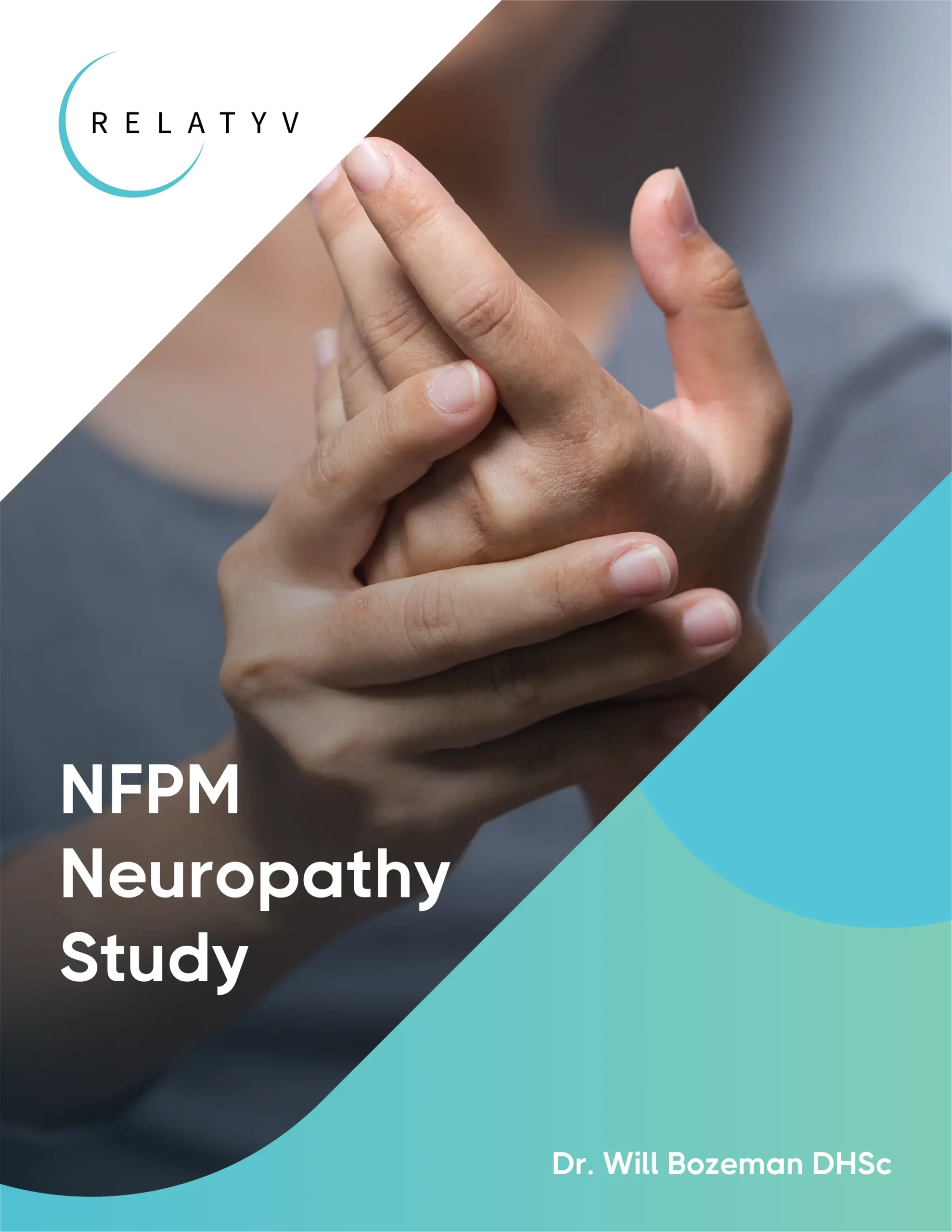
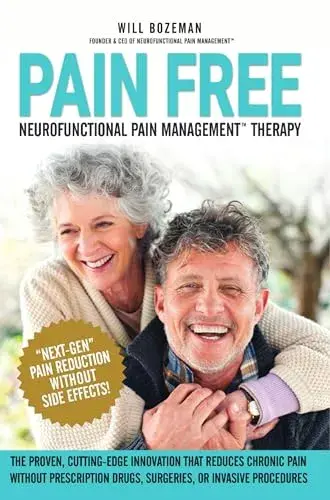
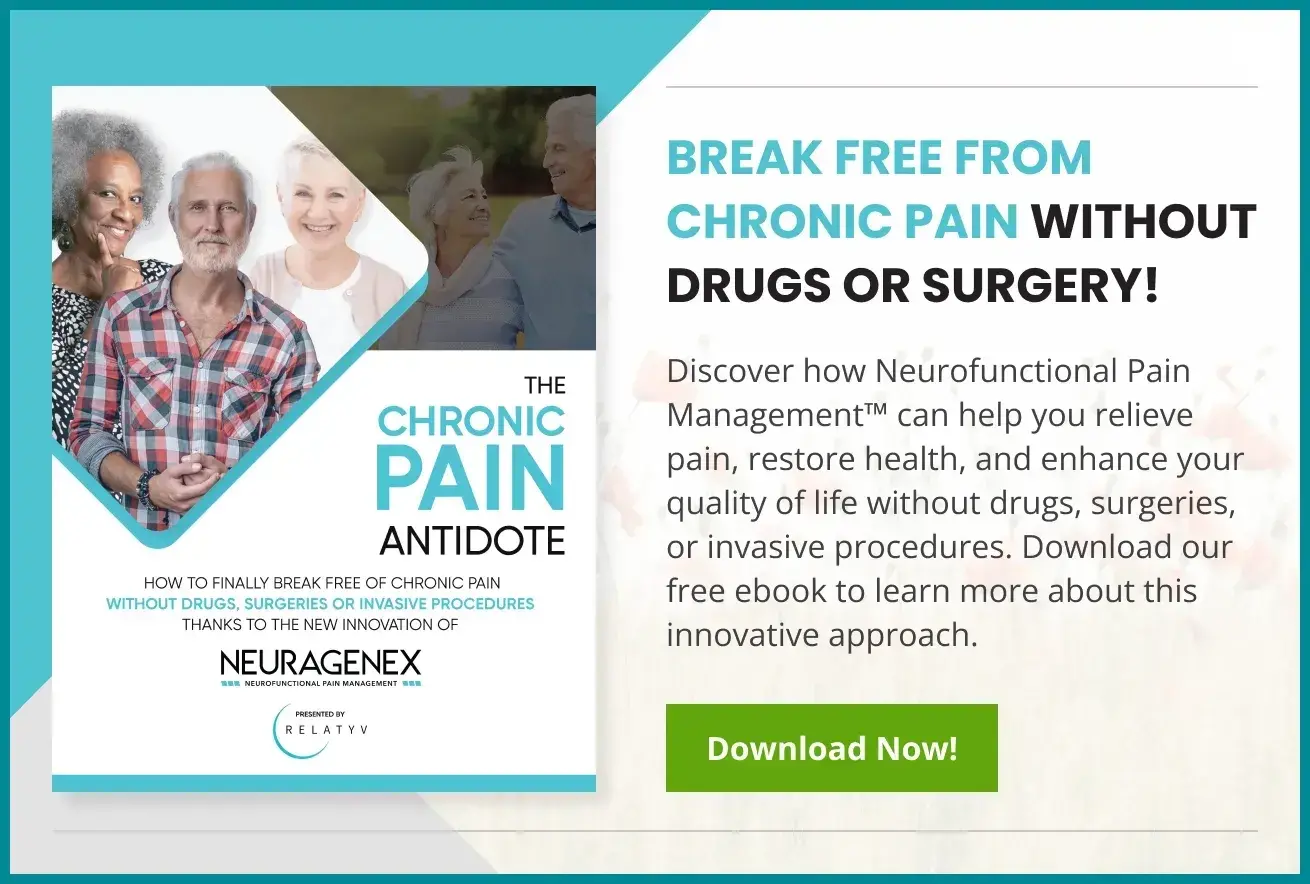
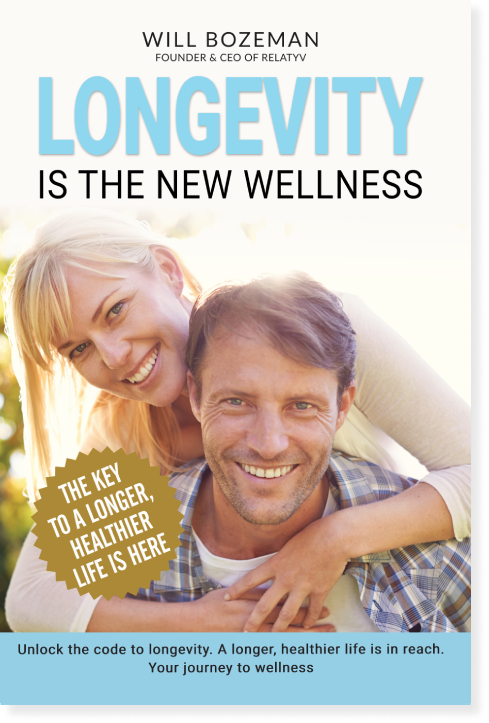
You can see how this popup was set up in our step-by-step guide: https://wppopupmaker.com/guides/auto-opening-announcement-popups/
You can see how this popup was set up in our step-by-step guide: https://wppopupmaker.com/guides/auto-opening-announcement-popups/
Neurofunctional Pain Management Overview
IV Therapy
Symptoms
Conditions Treated
Treatments
Articles by Category
Locations
Colorado
Wisconsin
Georgia
Hiram
Lawrenceville
Marietta
Powder Springs
Texas
Waco
Victoria
Illinois
Buffalo Grove
New Lenox
St. Charles
Arizona
Tucson
Waddell
Arlington
Avondale
Buckeye
Superior
Mesa
Palo Verde
Morristown
Tempe
Chandler
Anthem
Eloy
Florence
Fort McDowell
Phoenix
El Mirage
Coolidge
Gilbert
Arizona City
Casa Grande
Casa Blanca
Aguila
Sacaton
Apache Junction
Kearny
Stanfield
Goodyear
Litchfield Park
Alabama
Arkansas
California
Florida
Idaho
Michigan
Rhode Island
Minnesota
New Mexico
North Carolina
Ohio
Pennsylvania
South Dakota
Tennessee
Virginia

